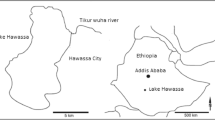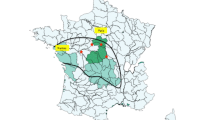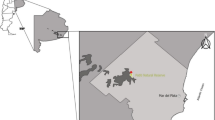Abstract
Tissue samples from 56 bird and 11 mammal species of different trophic levels, collected from 1994 to 1995 from the Urbino–Pesaro area in the Marche region of central Italy, were analyzed for the presence of organochlorine compounds (polychlorinated biphenyls and p,p′-DDE) and heavy metals (Pb, Cd, Cr, and Hg). Results revealed interspecies differences in pollutant residue concentrations. A clear relationship between contaminant and trophic levels emerged depending on several factors specific to the chemicals and the organisms, the importance of dietary accumulation, and metabolic capacity as it increased toward higher trophic levels. Polychlorinated biphenyls and p,p′-DDE were found in all of the bird and mammal species analyzed (bird- or fish-eating birds), and insectivore mammals showed the highest level of these contaminants. Pb and Hg residues were also widely detected and reflected trophic-level differences. The highest concentration of Pb was found in herbivorous or bird-eating aquatic invertebrates and in insectivorous mammals, particularly in the hedgehog (Erinaceus europaeus), whereas the highest Hg levels were found in fish-eating birds. All of the other heavy metals were detected at low concentrations and represented background levels for birds and mammals, with the exception of increased amounts of Cd and Cr, respectively, found in stone marten (Martes foina) and fox (Vulpes vulpes). Data from this study provided information on baseline levels of interest to monitor status and trends in chemical residue in biota in this specific area, and therefore they represent a tool to evaluate potential ecologic, wildlife, and human health exposure.

Similar content being viewed by others
References
Burger J (2002) Food chain differences affect heavy metals in bird eggs in Barnegat Bay, New Jersey. Environ Res 90:33–39
Carson R (1962) Silent spring. Houghton Mifflin, New York, NY
Choi JW, Matsuda M, Kawano M, Min BY, Wakimoto T (2001) Accumulation profiles of persistent organochlorines in waterbirds from an estuary in Korea. Arch Environ Contam Toxicol 41:353–363
Colborn T, Short P, Gilbertson M (1998) Health effects of contemporary-use pesticides: The wildlife/human connection. Toxicol Ind Health 15:1–2
Cooke AS, Bell AA, Haas MB (1981) Predatory birds, pesticides and pollution. Institute of Terrestrial Ecology, Cambridge, MA
Cuomo V, De Salvia MA, Petruzzi S, Alleva E (1996) Appropriate end points for the characterization of behavioral changes in developmental toxicology. Environ Health Perspect 104:307–315
De Liguoro M, Amorena M, Naso B, Donato A, Lucisano A (2002) Levels of p,p’-DDE in liver of predatory birds from Calabria, Italy. Bull Environ Contam Toxicol 68:377–382
Dessì-Fulgheri F, Gobbetti A, Mannucci P, Mirabelli P, Simonetta A (1981) Studio di una popolazione di Falconiformi in Sila Grande (Calabria) e dell’inquinamento da pesticidi clorurati presenti nell’ambiente. Atti Soc Tosc Sci Nat 88:21–33
Domingo JL (1994) Metal-induced developmental toxicity in mammals: A review. J Toxicol Environ Health 42:123–141
Donaldson GM, Braune BM (1999) Sex-related levels of selenium, heavy metals, and organochlorine compounds in American white pelicans (Pelecanus erythrorhyncos). Arch Environ Contam Toxicol 37:110–114
Donato A, Amorena M, Severino L, Caloni F, Pompa G, Lucisano A (1996) Primi dati di un’indagine sui livelli di contaminazione da pesticidi organoclorurati in uccelli rapaci. Suppl Ric Biol Selvaggina 24:251–259
Engelhart A, Behnisch P, Hagenmaier H, Apfelbach R (2001) PCBs and their putative effects on polecat (Mustela putorius) populations in Central Europe. Ecotoxicol Environ Saf 48:178–182
Facemire CF, Gross TS, Guillette LJ, Jr. (1995) Reproductive impairment in the Florida panther: nature or nurture? Environ Health Perspect 103:79–86
Focardi S, Leonzio C, Fossi C (1988) Variations in polychlorinated biphenyl congener composition in eggs of Mediterranean water birds in relation to their position in the food chain. Environ Pollut 52:243–255
Fowler BA (1992) Mechanisms of kidney cell injury from metals. Environ Health Perspect 100:57–63
Fox GA, Donald T (1980) Organochlorine pollutants, nest-defense behavior and reproductive success in marlins. Condor 82:81–84
Fox GA, Gilman AP, Peakall DB, Anderka FW (1978) Aberrant behavior of nesting gulls. J Wildl Manage 42:477–483
Haave M, Ropstad E, Derocher AE, Lie E, Dahl E, Wiig O, et al. (2003) Polychlorinated biphenyls and reproductive hormones in female polar bears at Svalbard. Environ Health Perspect 111:431–436
Hayes T, Haston K, Tsui M, Hoang A, Haeffele C, Vonk A (2002) Herbicides: Feminization of male frogs in the wild. Nature 419:895–896
Henny CJ (1977) Birds of prey, DDT, and tussock moths in Pacific Northwest. Trans N Am Wild Nat Res Conf 42:397–411
Janssens E, Dauwe T, Van Duyse E, Beernaert J, Pinxten R, Eens M (2003) Effects of heavy metal exposure on aggressive behavior in a small territorial songbird. Arch Environ Contam Toxicol 45:121–127
Jarman WM, Burns SA, Bacon CE, Rechtin J, DeBenedetti S, Linthicum JL, et al. (1996) High levels of HCB and DDE associated with reproductive failure in prairie falcons (Falco mexicanus) from California. Bull Environ Contam Toxicol 57:8–15
Kannan K, Corsolini S, Imagawa T, Focardi S, Giesy JP (2002) Polychlorinated-naphthalenes, -biphenyls, -dibenzofurans and p,p’-DDE in bluefin tuna, swordfish, cormorants and barn swallows from Italy. Ambio 31:207–211
Konstantinou IK, Goutner V, Albanis TA (2000) The incidence of polychlorinated biphenyl and organochlorine pesticide residues in the eggs of the cormorant (Phalacrocorax carbo sinensis): An evaluation of the situation in four Greek wetlands of international importance. Sci Total Environ 257:61–79
Larsson P, Woin P, Knulst J (1990) Differences in uptake of persistent pollutants for predators feeding in aquatic and terrestrial habitats. Holist Ecol 13:149–155
Leonards PEG, Hattum VB, Cofino WP, Brinkman UAT (1994) Occurrence of non-ortho-, mono-ortho- and di-ortho substituted PCBs congeners in different organs and tissues of polecats (Mustela putorius). Environ Toxicol Chem 13:129–142
Lopez-Martin J, Ruiz-Olmo J, Palazon Minano S (1994) Organochlorine residues in the European mink (Mustela lutreola) in Northern Spain. Ambio 23:294–295
Marsili L, Focardi S, Muller C, Maffi A, Casini L, Tinarelli R (1995) Organoclorurati in uova di tre specie ornitiche nidificanti nella Salina di Cervia (RA). Atti Decca Società Italiana di Ecologia 16:361–363
Mateo R, Guitart R (2003) Heavy metals in livers of waterbirds from Spain. Arch Environ Contam Toxicol 44:398–404
Naso B, Perrone D, Ferrante MC, Zaccaroni A, Lucisano A (2003) Persistent organochlorine pollutants in liver of birds of different trophic levels from coastal areas of Campania, Italy. Arch Environ Contam Toxicol 45:407–414
Newton I (1979) Population ecology of raptors. Harrell Books, England, UK
Newton I, Bogan J (1974) Organochlorine residues, eggshell thinning and hatching success in British sparrowhawks. Nature 249:582–583
Newton I, Wyllie I, Asher A (1991) Mortality causes in British Barn Owls Tyto alba, with a discussion of aldrin-dieldrin poisoning. Ibis 133:162–169
O’Brien DJ, Kaneene JB, Poppenga RH (1993) The use of mammals as sentinels for human exposure to toxic contaminants in the environment. Environ Health Perspect 99:351–368
Outridge PM, Scheuhammer AM (1993) Bioaccumulation and toxicology of chromium: implications for wildlife. Rev Environ Contam Toxicol 130:31–77
Peakall DB (1992) Animal biomarkers as pollution indicators. Chapman and Hall, London, UK
Platonow NS, Karstad LH (1973) Dietary effects of polychlorinated biphenyls on mink. Can J Comp Med 37:391–400
Ratclie DA (1967) Decrease in eggshell weight in certain birds of prey. Nature 215:208–210
Reinecke AJ, Reinecke SA, Musilbono DE, Chapman A (2000) The transfer of lead (Pb) from earthworms to shrews (Myosorex varius). Arch Environ Contam Toxicol 39:392–397
Savinov VM, Gabrielsen GW, Savinova TN (2003) Cadmium, zinc, copper, arsenic, selenium and mercury in seabirds from the Barents Sea: Levels, inter-specific and geographical differences. Sci Total Environ 306:133–158
Shore RF, Douben PE (1994) Predicting ecotoxicological impacts of environmental contaminants on terrestrial small mammals. Rev Environ Contam Toxicol 134:49–89
Stahl RGJ (1997) Can mammalian and non-mammalian “sentinel species” data be used to evaluate the human health implications of environmental contaminants. Human Ecol Risk Assess 3:329–335
Stansley W, Roscoe DE, Hawthorne E, Meyer R (2001) Food chain aspects of chlordane poisoning in birds and bats. Arch Environ Contam Toxicol 40:285–291
Talmage SS, Walton BT (1991) Small mammals as monitors of environmental contaminants. Rev Environ Contam Toxicol 119:47–145
van der Schalie WH, Gardner HS Jr, Bantle JA, De Rosa CT, Finch RA, Reif JS, et al. (1999) Animals as sentinels of human health hazards of environmental chemicals. Environ Health Perspect 107:309–315
Wern CD (1986) Mammals as biological monitors of environmental metal levels. Environ Monit Assess 6:127–144
Willerroider M (2003) Roaming polar bears reveal Arctic role of pollutants. Nature 426:5
Acknowledgments
This study was financed by a grant from the joint programme Ministry of Health-Istituto Zooprofilattico Sperimentale dell’Umbria e delle Marche and by ISS- INRM project Rischio Etotossicologico in Ambiente Montano: Individuazione di Popolazioni Sentinella di Vertebrati. We thank professor Tersilio Frescura for substantial scientific help, Giovanni Dominici for technical support, and Elena de Felip for critical reading of the manuscript.
Author information
Authors and Affiliations
Corresponding author
Rights and permissions
About this article
Cite this article
Alleva, E., Francia, N., Pandolfi, M. et al. Organochlorine and Heavy-Metal Contaminants in Wild Mammals and Birds of Urbino-Pesaro Province, Italy: An Analytic Overview for Potential Bioindicators. Arch Environ Contam Toxicol 51, 123–134 (2006). https://doi.org/10.1007/s00244-005-0218-1
Received:
Accepted:
Published:
Issue Date:
DOI: https://doi.org/10.1007/s00244-005-0218-1




